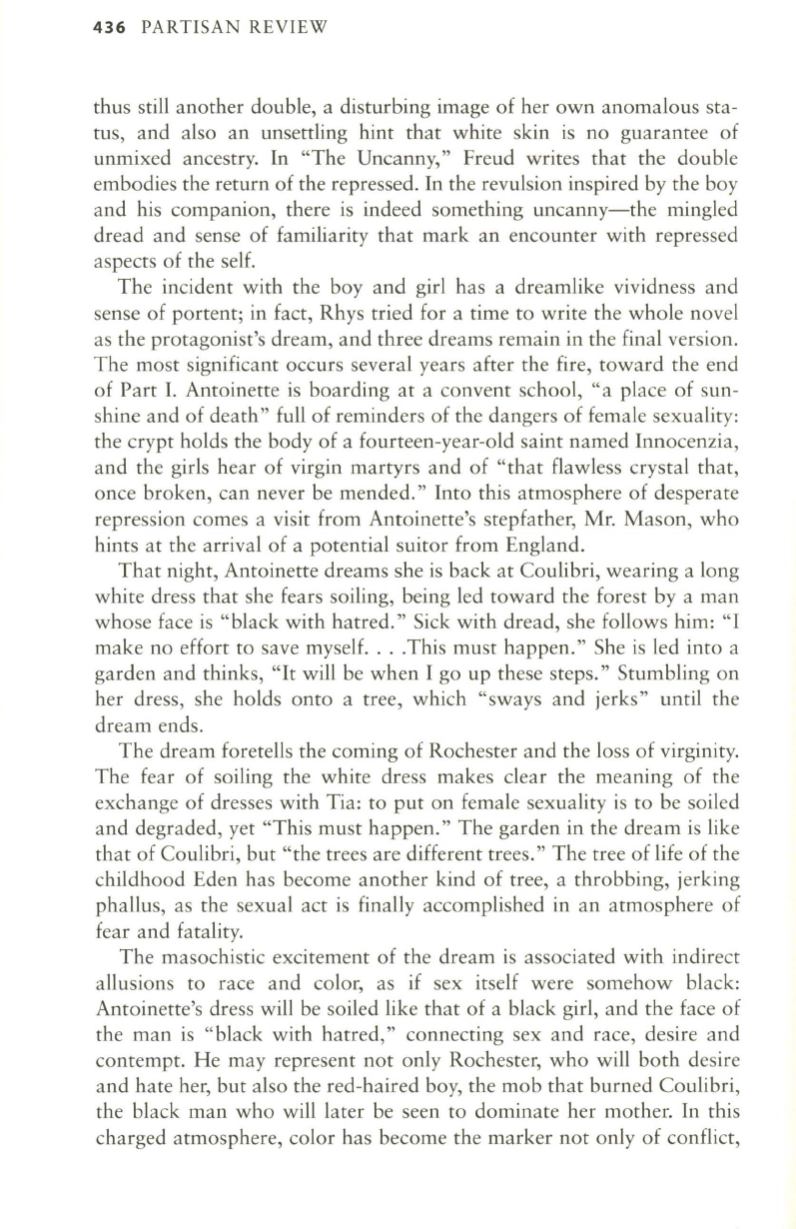
436
PARTISAN REVIEW
thus still another double, a disturbing image of her own anomalous sta–
tus, and also an unsettling hint that white skin is no guarantee of
unmixed ancestry. In "The Uncanny," Freud writes that the double
embodies the return of the repressed. In the revulsion inspired by the boy
and his companion, there is indeed something uncanny-the mingled
dread and sense of familiarity that mark an encounter with repressed
aspects of the self.
The incident with the boy and girl has a dreamlike vividness and
sense of portent; in fact, Rhys tried for a time to write the whole novel
as the protagonist's dream, and three dreams remain in the final version.
The most significant occurs several years after the fire, toward the end
of Part
I.
Antoinette is boarding at a convent school, "a place of sun–
shine and of death" full of reminders of the dangers of female sexuality:
the crypt holds the body of a fourteen-year-old saint named Innocenzia,
and the girls hear of virgin martyrs and of "that flawless crystal that,
once broken, can never be mended." Into this atmosphere of desperate
repression comes a visit from Antoinette's stepfather, Mr. Mason, who
hints at the arrival of a potential suitor from England.
That night, Antoinette dreams she is back at Coulibri, wearing a long
white dress that she fears soiling, being led toward the forest by a man
whose face is "black with hatred." Sick with dread, she follows him: " I
make no effort to save myself....This must happen." She is led into a
garden and thinks, "It will be when I go up these steps." Stumbling on
her dress, she holds onto a tree, which "sways and jerks" until the
dream ends.
The dream foretells the coming of Rochester and the loss of virginity.
The fear of soiling the white dress makes clear the meaning of the
exchange of dresses with Tia: to put on female sexuality is to be soiled
and degraded, yet "This must happen." The garden in the dream is like
that of Coulibri, but "the trees are different trees." The tree of life of the
childhood Eden has become another kind of tree, a throbbing, jerking
phallus, as the sexual act is finally accomplished in an atmosphere of
fear and fatality.
The masochistic excitement of the dream is associated with indirect
allusions to race and color, as if sex itself were somehow black:
Antoinette's dress will be soiled like that of a black girl, and the face of
the man is "black with hatred," connecting sex and race, desire and
contempt. He may represent not only Rochester, who will both desire
and hate her, but also the red-haired boy, the mob that burned Coulibri,
the black man who will later be seen to dominate her mother. In this
charged atmosphere, color has become the marker not only of conflict,


